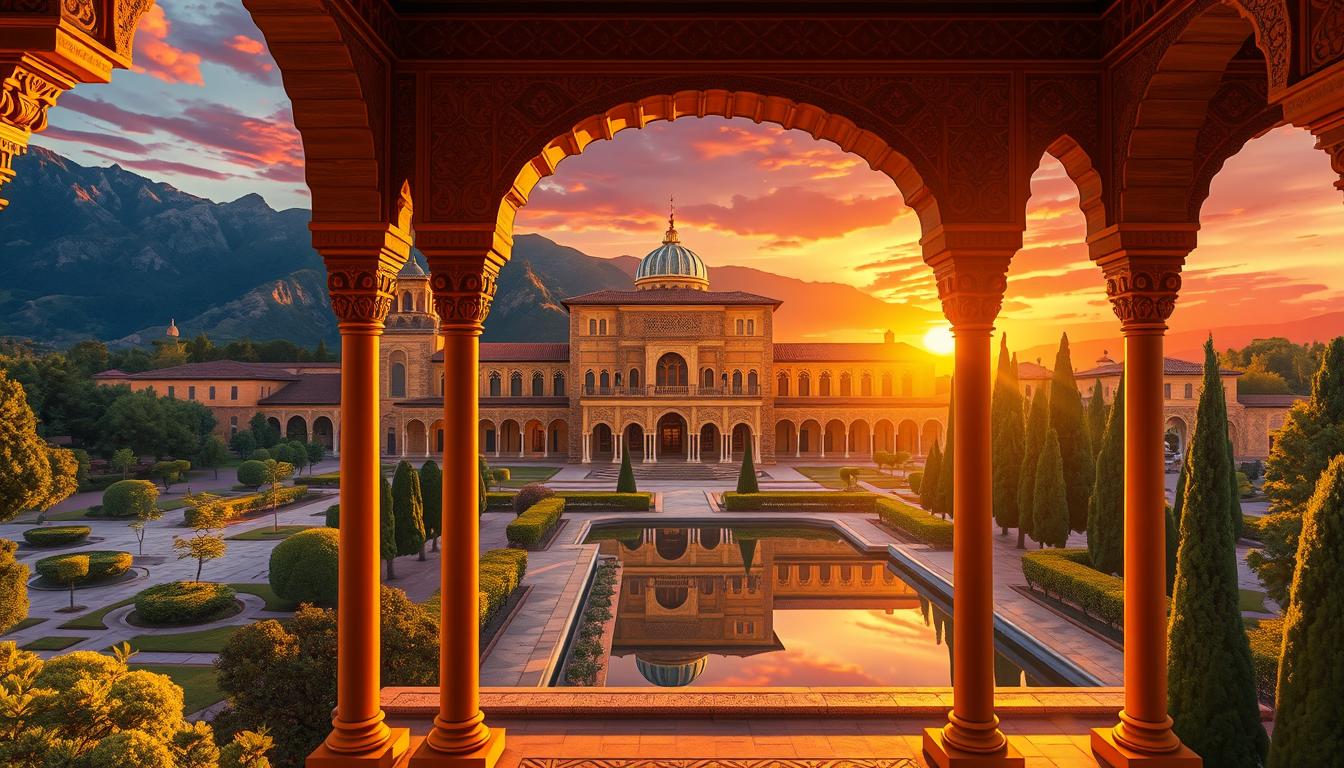Islam in Spain
The Muslim population in Spain represents a staggering 4.45% of the total Spanish population as of 2019, with an estimated 2.5 million Muslims projected to reside in the country by 2024, constituting around 5.32% of the total population. This remarkable presence of Islam in Spain has its roots in a rich and captivating history that spans over a millennium, from the Umayyad conquest of Hispania in the early 8th century to the gradual decline of overt Muslim influence in the 16th century.
The story of Islam’s impact on the Iberian Peninsula is one of cultural exchange, architectural marvels, and the coexistence of diverse faiths. As the Muslim civilization took hold in Spain, known as Al-Andalus, it gave rise to a flourishing society that left an indelible mark on the region’s art, literature, and scientific advancements. From the iconic Cordoba Mosque to the breathtaking Alhambra Palace in Granada, the legacy of Islamic architecture continues to captivate visitors from around the world.
Key Takeaways
- Islam had a significant presence in Spain for over a millennium, from the 8th to 16th centuries.
- The Muslim population in Spain currently represents around 4.45% of the total population, with an estimated 2.5 million Muslims by 2024.
- The Umayyad dynasty’s rule in Al-Andalus (756-1031) marked a golden age of learning, art, and architecture.
- Islamic influence in Spain is evident in the country’s rich architectural heritage, such as the Cordoba Mosque and the Alhambra Palace.
- The coexistence of Muslims, Christians, and Jews, known as convivencia, was a defining feature of Islamic Spain.
The Conquest of Iberia
The Umayyad conquest of Hispania, also known as the Muslim invasion of the Iberian Peninsula, marked a pivotal moment in the history of the region. In 711 AD, the Umayyad Caliphate’s Tariq ibn-Ziyad led a force of around 7,000 men from North Africa to southern Spain, initiating a decisive campaign that would eventually bring most of the Visigothic Kingdom under Muslim rule.
The Invasion from North Africa
Tariq’s initial expedition was reinforced by the arrival of an additional 18,000 mostly Arab troops under the command of his superior, wali Musa ibn Nusayr. This combined force rapidly captured key cities such as Seville and defeated the supporters of the last Visigothic king, Roderick, at Mérida and Talavera. The success of the Islamic forces can be partly attributed to the political instability and lack of integration within Hispano-Visigoth society.
The Battle of Guadalete and Fall of the Visigoths
The decisive moment came at the Battle of Guadalete, where Tariq’s forces decisively defeated the Visigothic army led by King Roderick. This victory paved the way for the Umayyad conquest of Hispania, with the Caliphate’s forces bringing most of the Visigothic Kingdom under their control within the span of seven years.
“The chronicle of 754 stated that many townspeople fled to the hills rather than defend their cities during the conquest.”
The Umayyad Caliphate quickly organized the conquered territories into the province of Al-Andalus, with the regional capital established in Córdoba. The initial Muslim forces consisted primarily of Berbers, while later Arab settlers and Mawali (non-Arab Muslims) were also incorporated into the administration and military of the new province.
The Umayyad Caliphate’s Rule
The Umayyad Caliphate’s rule in Al-Andalus spanned over 300 years, with the Emirate of Córdoba (c. 750-929) and the Caliphate of Córdoba (929-1031) as the predominant political entities. Under Umayyad governance, the city of Córdoba emerged as a leading cultural and economic center throughout the Mediterranean Basin, Europe, and the Islamic world.
Expansion and Consolidation of Power
In 711, an army of Arabs and Berbers under the Umayyad caliphs of Damascus conquered most of the Iberian Peninsula within seven years, establishing Muslim rule. ‘Abd al-Rahman I (reigned 756-788) escaped to Spain after the fall of the Umayyad dynasty in Syria in 750 and established autonomous rule in Córdoba. During ‘Abd al-Rahman III’s reign (912-961), al-Andalus expanded into an empire with a diverse religious and ethnic population.
Achievements in Art, Architecture, and Science
The Umayyad period in Córdoba saw a revival and nostalgia for Umayyad rule in the Islamic world. Art patronage was significant during this time, leading to the commissioning of luxury objects and the decoration of palaces with intricate materials like marble, ivory, silver, and silk. Between 945 and 1010, the Umayyad court was centered in Madinat al-Zahra, a palace city near Córdoba established by ‘Abd al-Rahman III, showcasing opulent and sophisticated architecture.
Significant achievements in Islamic and Western science also came from Al-Andalus during the Umayyad Caliphate’s rule, including major advances in trigonometry, astronomy, surgery, pharmacology, and agronomy.
“The Umayyad Caliphate’s rule in Al-Andalus spanned over 300 years, with the Emirate of Córdoba (c. 750-929) and the Caliphate of Córdoba (929-1031) as the predominant political entities.”
The Golden Age of Al-Andalus
The Umayyad rule in Al-Andalus ushered in a remarkable period of cultural and intellectual prosperity known as the Golden Age of Al-Andalus. During this time, the region experienced significant advancements in art, architecture, literature, and science, as Muslim, Jewish, and Christian scholars and artisans coexisted and collaborated. Córdoba, the capital, became a renowned center of learning, attracting scholars and thinkers from across the Mediterranean. The achievements of this era laid the foundation for cultural exchange and the transmission of knowledge between the Islamic and Christian worlds.
The cultural and intellectual advancements during the Golden Age of Al-Andalus were truly remarkable. Córdoba, the capital, was a thriving hub of activity, boasting a vast library, numerous schools, and a vibrant intellectual community. Scholars from diverse backgrounds came together to share their knowledge and ideas, leading to groundbreaking discoveries in fields such as mathematics, astronomy, and medicine.
“The period of Arab Muslim rule over the Iberian peninsula was considered a time when Muslims, Jews, and Christians lived relatively peacefully together, fostering a common culture and harmonious society.”
However, the idea of a peaceful and harmonious coexistence, known as convivencia, has been the subject of ongoing debate among historians. While the Golden Age undoubtedly witnessed significant cultural and intellectual advancements, the realities of daily life for minority groups, such as Christians and Jews, were often more complex and nuanced.
Nonetheless, the legacy of the Golden Age of Al-Andalus continues to be celebrated and studied, serving as a testament to the power of cross-cultural collaboration and the enduring spirit of human creativity and innovation.
Islam in Spain: A Melting Pot of Cultures
Al-Andalus, the Muslim-ruled region of the Iberian Peninsula, was once characterized by a remarkable degree of religious and cultural Convivencia, or interfaith coexistence. Under Muslim rule, Muslims, Christians, and Jews were able to thrive and contribute to the development of society and culture, creating a vibrant cultural exchange that left a lasting impact on the region and beyond.
Convivencia: The Coexistence of Muslims, Christians, and Jews
The extent of this peaceful Convivencia is debated by scholars, but it is clear that the Iberian Peninsula became a melting pot where the three major monotheistic faiths benefited from the blooming of philosophy, the medieval sciences, and a flourishing of the arts. This period of cultural exchange had a profound influence that reverberated throughout the region and the world.
“Spain has largely resisted right-wing populism seen in other European nations, with Islamophobia described as ‘relatively weak’ according to a 2016 report from the Elcano Royal Institute think tank.”
Despite the historical significance of this era of Convivencia, today’s Spain has a relatively small Muslim population, with only 2.1% of the population identifying as Muslim in 2010 according to Pew Research Center figures. However, the Muslim presence in Spain is expected to grow, reaching an estimated 3.3% by 2020.
The legacy of Al-Andalus and the cultural exchange that occurred during that time continues to be a topic of great interest and study. Initiatives like the European Union-funded “The European Quran” project, led by Spanish researcher Mercedes Garcia-Arenal, aim to document the rich history of Islam’s influence in Europe, shedding light on this remarkable period of interfaith coexistence.
Intellectual and Scientific Advancements
Al-Andalus, the Muslim-ruled territory in medieval Spain, was a hub of intellectual and scientific advancement during its Golden Age. Scholars and scientists from the region made significant contributions to various fields, including mathematics, astronomy, and medicine, which played a crucial role in the transmission of knowledge between the Islamic and Christian worlds.
Contributions to Mathematics, Astronomy, and Medicine
In mathematics, the work of scholars like Jabir ibn Aflah in trigonometry and Al-Khwarizmi’s groundbreaking focus on equations and algebraic operations laid the foundation for mathematical developments in Al-Andalus. Astronomers such as Al-Zarqali studied Ptolemy’s Almagest and corrected the astronomical tables of Al-Khwarizmi, further advancing the field.
In the realm of medicine, Al-Zahrawi’s pioneering work in surgery and Ibn Zuhr’s contributions to pharmacology demonstrated the high level of Islamic science in Al-Andalus. These advancements in mathematics, astronomy, and medicine showcased the intellectual prowess of the region and its influence on the wider world.
“The intellectual achievements of Al-Andalus played a crucial role in the transmission of knowledge between the Islamic and Christian worlds.”
The Al-Andalus contributions to various fields of Islamic science have had a lasting impact, with the widespread use of Arabic numerals and the continued importance of Spanish olive oil and citrus fruits being just a few examples of their enduring legacy.
The vibrant intellectual and scientific environment in Al-Andalus, fueled by the coexistence of diverse cultures and the exchange of ideas, has left an indelible mark on the development of knowledge and the advancement of both Islamic and Western civilizations.
The Taifa Kingdoms
After the collapse of the Umayyad Caliphate of Córdoba in 1031, the once-unified Muslim rule in the Iberian Peninsula began to fracture. Al-Andalus, the Islamic territories in Spain, fragmented into numerous independent Taifa kingdoms. These smaller principalities engaged in constant political and military rivalries, often seeking alliances with the Christian kingdoms to the north in an effort to counter their growing power.
The Taifa period was marked by a decline in political unity and power. The once-dominant Muslim control over the region started to wane in the face of the advancing Christian Reconquista. Around 33 independent Taifa kingdoms emerged during this tumultuous time, with the most powerful being the Taifa of Zaragoza, Taifa of Toledo, Taifa of Badajoz, and the Taifa of Seville.
The Taifa kingdoms experienced shifting power dynamics, with some rulers managing to conquer their weaker neighbors, while others were eventually incorporated into larger North African empires or Christian kingdoms. The Taifa of Seville, under the Abbadid dynasty, notably conquered most of its neighboring Taifa states, becoming one of the most dominant powers in the region.
Despite the political fragmentation, the Taifa period also saw a cultural renaissance, with centers like the courts of Seville and Toledo attracting poets, scientists, and scholars. The Taifa Kingdom of Almería, in particular, was known for its developed textile industry and thriving commerce network with other parts of Europe.
“The Taifa period was a time of both political instability and cultural flourishing in Al-Andalus, as the once-unified Muslim rule gave way to a patchwork of competing kingdoms.”
The Taifa kingdoms ultimately paved the way for the eventual Christian Reconquista, as the fragmentation of Al-Andalus weakened the Muslim hold over the Iberian Peninsula. This set the stage for the advancing Christian kingdoms to gradually reclaim territory and solidify their control over the region.
The Almoravid and Almohad Dynasties
In the 11th and 12th centuries, the Almoravid and Almohad dynasties, based in North Africa, exerted significant influence over the remaining Muslim territories in the Iberian Peninsula. The Almoravids initially intervened to repel the Christian attacks on Al-Andalus, but their rule was later challenged by the Almohads, who brought the region under their direct control. The North African empires played a crucial role in the history of Al-Andalus, as they sought to maintain Muslim power in the face of the advancing Christian Reconquista.
North African Influence on Al-Andalus
The Almoravid Empire (al-Murabitun) existed from ca. 1062 to 1150 and controlled territories in the Sahara, Morocco, Algeria, and Spain. Their ruler, ‘Ali ibn Yusuf, reigned from 1106 to 1142 and commissioned the impressive minbar (pulpit) of the Kutubiyya Mosque in Marrakesh in 1137. The Almohad Caliphate (al-Muwahhidun) then rose to power, thriving from 1150 to 1269 and taking control of Morocco and several cities in the Iberian Peninsula, including Seville, Córdoba, Badajoz, and Almería.
- The Almoravids were crucial in temporarily halting the advance of Christian kingdoms in Al-Andalus, notably at the Battle of Sagrajas in 1086.
- The Almohads experienced a significant defeat at the Battle of Las Navas de Tolosa in 1212 by the combined armies of Aragon and Castile.
- Architectural developments during the Almohad period included the construction of the Great Mosque and La Giralda in Seville, as well as various mosques and fortifications across North Africa.
The Almoravid and Almohad dynasties played a pivotal role in shaping the history of Al-Andalus, as they sought to maintain Muslim power in the face of the advancing Christian Reconquista. Their influence on the region’s art, architecture, and culture was profound and lasting.
“The Almoravids and Almohads were crucial in shaping the destiny of Al-Andalus, as they sought to defend the region’s Muslim heritage against the relentless advance of the Christian Reconquista.”
The Reconquista
The Reconquista, or the Christian reconquest of the Iberian Peninsula, was a prolonged struggle that ultimately led to the end of Muslim rule in the region. Over the course of approximately 781 years, from the Battle of Covadonga in the late 8th century to the fall of Granada in 1492, the Christian kingdoms in the north, led by Castile and Aragon, gradually pushed southward, capturing territory from the weakened Muslim states.
A significant event in the Reconquista was the Battle of Las Navas de Tolosa in 1212, which marked the defeat of Muslim forces by Christian armies. This victory paved the way for the Christian conquest of the south, with the fall of Córdoba in 1236 being a turning point. By 1250, nearly all of Iberia was under Christian rule, except for the Muslim kingdom of Granada, which lasted until its surrender to Queen Isabella I of Castile in 1492, completing the Christian Reconquista of Spain.
The Reconquista had far-reaching consequences, including the expulsion of Jewish communities in Castile and Aragon, totaling around 200,000 individuals, and the forced conversion of Muslims in Castile, Navarre, and Aragon between 1499 and 1526. The Reconquista is also commemorated in the Moros y Cristianos festival, which is popular in Southeastern Spain and former Spanish colonies.
Source Links
- Spain – Muslim Rule, Reconquista, Culture
- Islam in Spain
- BBC – Religions – Islam: Muslim Spain (711-1492)
- Muslim conquest of the Iberian Peninsula
- Al-Andalus
- The Spanish Umayyads (711–1031)
- The Art of the Umayyad Period in Spain (711–1031) | Essay | The Metropolitan Museum of Art | Heilbrunn Timeline of Art History
- Al-Andalus | Facts, History, & Maps
- Lessons from the Golden Era of Andalusia
- The Golden Age in Spain: How golden was it?
- Rediscovering Spain’s Islamic heritage | CNN
- The Iberian Peninsula and the influences Islam had on its culture
- Science in al-Andalus
- The Science and Culture of Islamic Spain
- Taifa
- Taifa of Almería
- The Art of the Almoravid and Almohad Periods (ca. 1062–1269) | Essay | The Metropolitan Museum of Art | Heilbrunn Timeline of Art History
- Almoravid dynasty
- Spain – Almoravids, Reconquista, Moors
- Reconquista
- Reconquista | Definition, History, Significance, & Facts
- The Reconquista | Western Civilization







